
New video evidence of how smaller drones are significantly strengthening Ukraine’s efforts to repel invading Russian forces has surfaced showing a self-made UAV using simple grenades to take out a $3 million Russian tank.
The video was posted this week by the Aerorozvidka unit, which has earned quite a reputation for itself by assembling and using relatively small, largely self-constructed drones to support Ukraine’s army battle Russian troops. A clip entitled “Re-educated russian tank” shows grainy black-and-white footage, presumably captured off the UAV’s connected controller, as it searches for the Russian T-90 tank, then accurately drops a pair of bombs on it.
“Our fighters destroyed the Russian T-90 ‘Vladimir’ tank in the southern direction of the front. Its price is $ 2.5-3.5 million,” the text accompanying the Aerorozvidka video says. “We continue to work for victory!”
According to a variety of reports on the group and its most recent strike, Aerorozvidka transitioned away from using commercial drones it had or received from donors abroad to building its own craft, known as the R18. It loads those with Soviet-era or other relatively cheap munitions to attack – and fairly frequently destroy – Russian tanks worth millions of dollars, and previously considered among Moscow’s most formidable military advantages.
Read more: Evidence arises of private drones flying to Ukraine’s defense against Russia
Earlier this month, a group commander identified as Mykhailo told the UK’s Mirror that the self-made R18 can fly heavier payloads than consumer alternatives, and “cost dozens of thousands of dollars” to assemble. He said Aerorozvidka techies are producing several new drones each day, some of which the group uses against Russian forces, while most are given to UAV units in Ukraine’s formal army.
Aerorozvidka has created what is becoming a well-furnished YouTube channel with footage of its work, often accompanied by serious head-banger music and – given the deadly matters at hand – incongruously playful descriptions like, “We are still turning tanks into cans!”
Read more: Even kids are donating their drones to Ukraine
Mykhailo said the R18s “have destroyed almost 100 Russian vehicles.” Those mechanical victims have included “armored personnel carriers, tanks, fuel trucks, and Grad missile launcher systems.”
Whether repurposed consumer craft or built-from-scratch UAVs, smaller drones have played a crucial role in Ukraine’s fight against Russian invaders, and have significantly supplemented the damage inflicted by military grade Bayraktar TB2s from Turkey. Last week a tweeted video purported to show a DJI Phantom dropping a grenade through the sunroof of a Russian vehicle as soldiers inside attempted to depart.
Read more: Drone performance in Ukraine may force military strategy rethink
The impressive performance of smaller drones flown by Ukraine fighters has been contrasted by less enviable – and at times risible – attention Russian UAVs have drawn to themselves.
Last month, video was released by a Ukraine division that captured a Russian Orlov-10 reconnaissance drone. Examination of it turned up a gas tank cap from a plastic water bottle, duct tape fastenings, and a store-bought Canon camera – with its settings glued in place – as its main component. Like that eye in the sky, none of the other internal components of the supposedly secret, high-tech UAV were made in Russia.
FTC: We use income earning auto affiliate links. More.

Comments